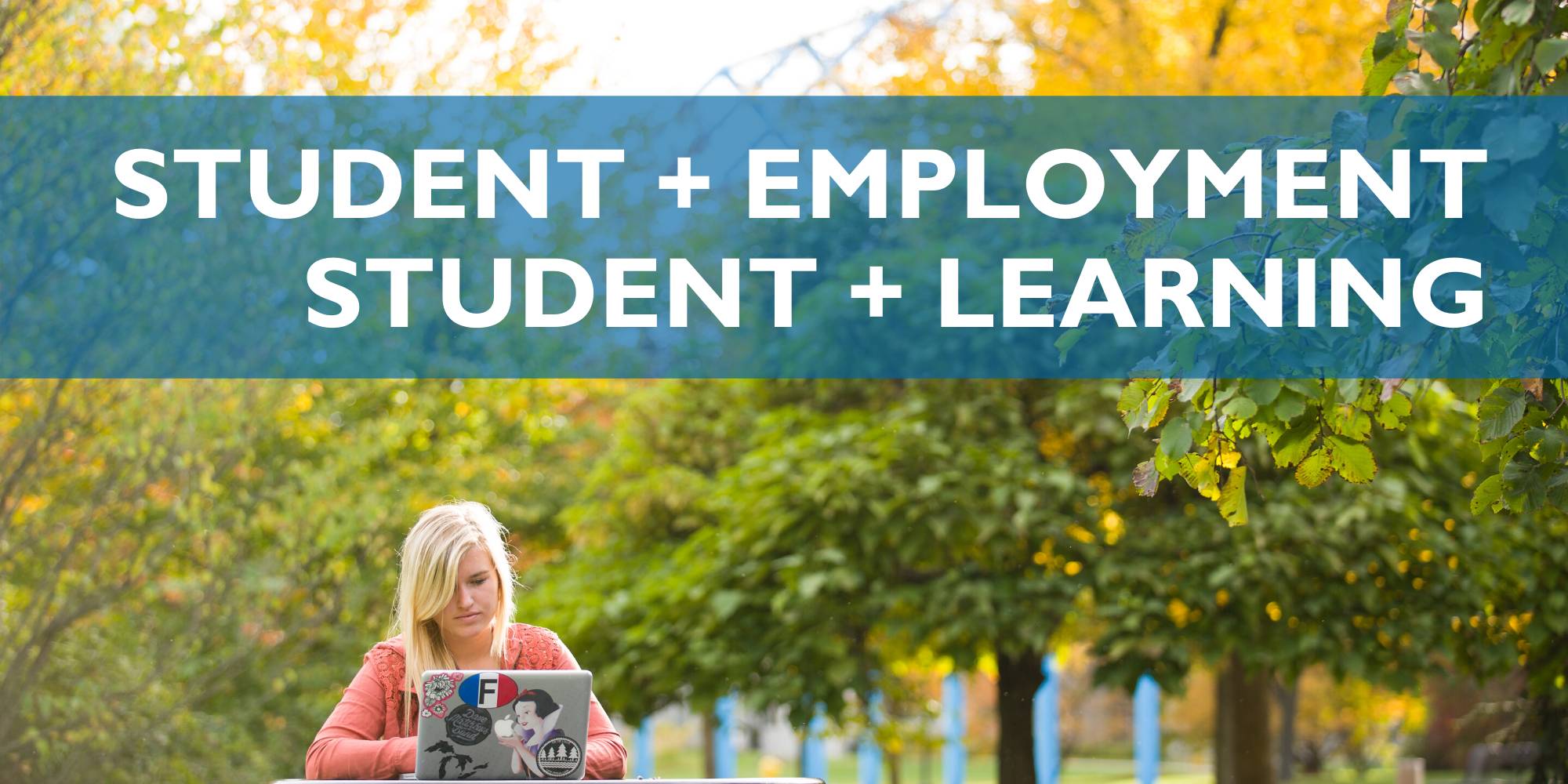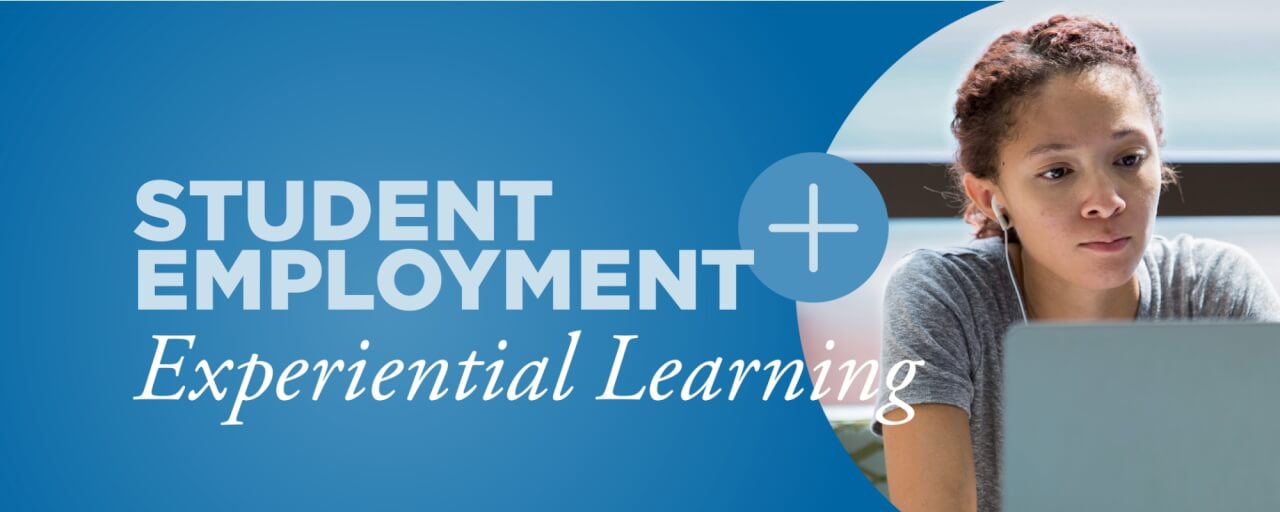Student Employment+

The "+" Is All About Experiential Learning.
Student Employment+ was launched Summer 2020, an initiative which seeks to leverage student employment as a means to provide students with an opportunity to engage in seamless learning, earn an income, and stay enrolled.
The Student Employment+ framework offers distinct advantages for a student employee:
- Job Crafting: SE+ positions allow students to formally direct their employment experience by establishing clear goals tied to career development or general professional growth.
- Collaboration: SE+ supervisors make a distinct commitment to help their student achieve these goals; it is a more collaborative relationship.
- Standardized Evaluations: Growth/progress is tracked by both the supervisor and student, with mid & end term evaluations.
Your Commitment as a Supervisor
- Posting student employment jobs on Handshake, job descriptions
- Partnering with student(s) in establishing learning objectives
- Administering a mid and end-term evaluations
- Elevating student responsibility tied to future career development
*Both in-person & virtual work

Creating an SE+ Experience
Preparation
Creating accurate job descriptions is essential to the recruitment process as it helps clarify who is responsible for what within your department and helps the student better understand the responsibilities of the position. An effective job description also helps you establish a better applicant pool, which will help you identify the best candidate for the position. The following elements should be included in an SE+ job description:
- Organization/Department Name: Division, location, etc.
- Description/Mission Statement of Department: It is helpful to include a few sentences about your department
- Job Title: Best to have it relate to the type of work and include SE+ in parenthesis (ie: Student Programming Assistant (SE+), Peer Educator (SE+), etc)
- Job Type: Be sure to indicate it as on-campus student employment.
- Reports to: Title of supervisor, location, describe management structure
- Opportunities and Experiences for the Student
- Responsibilities and Accountabilities: Principal duties, continuing responsibilities, and accountability
- Required/Preferred Qualifications: Focus on specific skill sets rather than majors/academic programs
- Compensation: Please refer to the wage chart. It is recommended to start a student at a minimum 3A level.
- How to Apply: Students can apply via our posting system, Handshake
Organization/Department Name: Padnos International Center
Description/Mission Statement of Department: Engage the University community in meaningful international experiences which foster an appreciation and awareness of diverse cultures, people, and ideas.
Job Title: International Student Services (ISS) Assistant (SE+)
Job Type: On-campus student employment
Reports to: This position is supervised by both Libby Jawish and Kate Stoetzner. The ISS Assistant will work most closely with Libby for daily tasks and reporting.
Opportunities and Experiences for the Student: The International Student Services (ISS) Assistant supports the team in planning, promoting, and executing events and programs involving the International Students at GVSU.
Duties and Responsibilities:
- Brainstorming, creating, and finding activities for International Students
- Social media maintenance including updates and promotion
- Posting events on GVSU’s main events calendar and ISS website
- Sharing events with the Lanthorn, GVSU’s official social media platforms, relevant student organizations, community organizations, and academic departments
- Assist in creating promotional materials as well as materials for various events
- Assist in maintaining PEEPS engagement throughout semester
- Locating and engaging volunteers for International Student Events
- Recruiting performers, speakers, participants for select programs
- Participate in the successful running of the Global Café
- Assist in conducting 30 day assessments
- Tabling and passing out flyers
- Updating ISS Intern guidebook
- Responsible use, care, and storage of ISS Laptop
- Documenting activities of ISS Intern & creating end of term report
- Attendance at events may be required
- Other support for ISS as needed
Required Skills and Attributes: This position requires between 3 to 10 hours of work per week, depending on the volume of work throughout the semester. A one semester commitment is required of the selected ISS Intern.
Compensation: $10.15/hour
How to Apply: Upload resume, cover letter, and class schedule to Handshake
Hiring/Onboarding
- Post a Job in Handshake (Make sure to include "(SE+)" in the job title)
- Interview Student(s)who Applied to Your Posting
- Finalize Hiring and Extend Offers
- Make Sure Students have an I-9 form on file with Student
Employment Office
- Students will need to email [email protected] with their G#s and Name. Student Employment will email students a secure link to upload their I-9s and other identity documents.
- Report a Hire on Student Employment Office’s Website. Add "SE+" to beginning of job title
- Create learning objectives with student to review throughout the semester
- All SE+ Positions must be posted via Handshake.
- SE+ posting should have job title and (SE+) next to title.
- View Handshake tutorial documents here:
Interviewing is a very important step in the recruitment process as you want to make sure the student will provide you with skills and abilities you’re looking for, as well as fit the needs of your department. If you have never conducted an interview before, you’ll find a sample outline below, including helpful questions and tips on using the interview to find the best candidate.
-
Open the interview (1-2 minutes)
- Build friendly rapport through small talk
- Provide an overview of the interview
- Indicate that the student will have an opportunity to ask questions later
-
Ask questions and gather information (15 minutes)
- Tell me about yourself
- Why are you interested in this position
- Why are you interested in this department
- What are your short and long term career goals
- Behavioral based questions:
- Tell me about a time you:
- Had to deal with a conflict
- Worked as part of a team
- Used creativity to solve a problem
- Dealt with a difficult customer/supervisor/colleague
- Managed a stressful situation
- Handled multiple tasks simultaneously
- Tell me about a time you:
- What are your strengths/weaknesses
- Specific questions related to technology/methodology used in your field
- Questions to avoid:
- How old are you? Do you have a disability? Are you married/have kids? What is your nationality?
-
Allow for the candidate to ask questions (5
minutes)
- Be prepared to answer questions about the position, expected training, department structure, department services
- Assess the quality of the student’s questions
-
Give information (1-2 minutes)
- Discuss candidate’s availability for the position to ensure your needs are met
-
Wrap-Up (1-2 minutes)
- Close on a positive note
- Briefly describe the next steps, giving an estimate of when the student will hear from you
- Avoid making statements that may be interpreted as a promise of employment
- Evaluate the candidate against the requirements for the position
-
Follow up with candidates promptly
- Offer to candidate that you have chosen
- Send rejection letters to students who do not match your requirements
Helping a new hire feel welcomed and comfortable within your department is very important. It will help the student become settled into his/her role and, in turn, provide you with the results you’re looking for faster. Below you’ll find a sample orientation outline that will help your student find his/her place within your organization.
- Review organization and department missions
- Give the student a feel for the organizational structure, provide an organizational chart or staff list with phone numbers
- Explain the need-to-know items. These may need to be adjusted for
virtual/remote experiences.
- Specific work dates and times
- Office hours, breaks and lunches
- Intranet
- Using office equipment, i.e., computer, phone
- Dress code
- Attendance and punctuality
- Review organizational and employee policies (**It is important to note that you’ll want to review your organization’s technology policy as it regards to personal use)
- Review the position and complete the SE+ Experiences form in
Handshake
- Establish learning objectives
- Identify and discuss main projects
- Job description
- Results expected
- Action plan
- Set weekly meetings with your student to review projects, provide feedback, and provide opportunity for reflective learning
- Set regular evaluation meetings (one 30 days in and one at the end of the internship)
- Inform the student of departmental or staff meetings he/she is expected to attend, and provide time during those meetings for the student to report progress on his/her project
- Identify a back-up supervisor or support person who can answer the student’s questions if his/her regular supervisor is unavailable
- Ensure that your student understands his/her responsibilities
- Provide a tour of the facility, introduction to staff
Facilitating Experiential Learning
One of the distinguishing factors of an SE+ experience is the connection between the work they are doing and the student’s career development. This is often accomplished through learning objectives.
What are they?
Learning objectives help the student identify what they are learning throughout the SE+ experience by connecting *competencies to specific projects or tasks. Learning objectives also provide supervisors concrete examples for evaluation purposes, both midway through the experience as well as at the conclusion of the experience.
How do you write them?
Learning objectives should be written by the student in conjunction with his/her supervisor. The student should identify three to five key elements they hope to learn while completing their projects. These skills can be specific to the student’s field, or more general skill-sets he/she wants to enhance. It’s important to make sure the learning objectives are measurable and achievable.
The supervisor can then help the student pinpoint what projects or work assignments will help the student achieve his or her objectives. Keep in mind that the learning objectives are not all about the student and should align with goals of the organization/department.
*See NACE Competencies
These are the career competencies outlined by the National Association of Colleges and Employers (NACE). These specific competencies have been identified as key attributes to helping college graduates becoming career ready:
- Critical Thinking/Problem Solving: Exercise sound reasoning to analyze issues, make decisions, and overcome problems. The individual is able to obtain, interpret, and use knowledge, facts, and data in this process, and may demonstrate originality and inventiveness.
- Oral/Written Communications: Articulate thoughts and ideas clearly and effectively in written and oral forms to persons inside and outside of the organization. The individual has public speaking skills; is able to express ideas to others; and can write/edit memos, letters, and complex technical reports clearly and effectively.
- Teamwork/Collaboration: Build collaborative relationships with colleagues and customers representing diverse cultures, races, ages, genders, religions, lifestyles, and viewpoints. The individual is able to work within a team structure, and can negotiate and manage conflict.
- Digital Technology: Leverage existing digital technologies ethically and efficiently to solve problems, complete tasks, and accomplish goals. The individual demonstrates effective adaptability to new and emerging technologies.
- Leadership: Leverage the strengths of others to achieve common goals, and use interpersonal skills to coach and develop others. The individual is able to assess and manage his/her emotions and those of others; use empathetic skills to guide and motivate; and organize, prioritize, and delegate work.
- Professionalism/Work Ethic: Demonstrate personal accountability and effective work habits, e.g., punctuality, working productively with others, and time workload management, and understand the impact of non-verbal communication on professional work image. The individual demonstrates integrity and ethical behavior, acts responsibly with the interests of the larger community in mind, and is able to learn from his/her mistakes.
- Career Management: Identify and articulate one's skills, strengths, knowledge, and experiences relevant to the position desired and career goals, and identify areas necessary for professional growth. The individual is able to navigate and explore job options, understands and can take the steps necessary to pursue opportunities, and understands how to self-advocate for opportunities in the workplace.
- Global/Intercultural Fluency: Value, respect, and learn from diverse cultures, races, ages, genders, sexual orientations, and religions. The individual demonstrates, openness, inclusiveness, sensitivity, and the ability to interact respectfully with all people and understand individuals’ differences.
Click on the links below to find out more information.
Learning Objective #1:
Gain an understanding of how to implement new technology within a department
Task/Work Assignment #1:
I will be working with my supervisor on a communication tool that helps recruit potential students to GVSU. This new tool will need to be monitored and assessed throughout implementation.
Learning Objective #2:
Enhance my written communication- specifically in regards to effective social media posts, public service announcements, and website content
Task/Work Assignment #2:
One of my main tasks will be customizing the communication that comes out of the new tool and department. I will need to ensure similar messages are coming through all platforms of communication
One of the great benefits of hiring a student is that they often bring a fresh new perspective to the organization and/or department. That being said, the SE+ experience is still a learning opportunity, and effective supervision is essential to make sure the experience is successful for both the student and organization.
Communication is critical when it comes to supervising. This helps to ensure expectations are clearly defined and both the student and supervisor are on the same page. It is recommended that weekly meetings are established where the student and supervisor can touch base. In addition, it’s helpful for the student to have another person they can go to with questions in case their direct supervisor is unavailable.
Providing a solid supervisor is important, but providing a mentor can take the SE+ experience from good to great! A mentoring relationship is similar to that of a supervisor’s relationship, however the mentor helps the student draw the connection between what they are doing in the workplace to what they have learned in the classroom through reflection. Having the student complete a self evaluation halfway through the experience, and again at the conclusion of the experience is a great way to do this. In addition, a mentor may help the student with additional professional development opportunities, as well as encouraging them to step outside of their comfort zone.
While the projects and work provided through an SE+ experience may inherently be experiential in nature, it is also helpful to check in with your student and help them draw connections between their work and future career goals. Some sample questions to ask include:
- How is your job fitting in with your academics?
- What are you learning here that is helping you in school?
- What are you learning in class that you can apply here at work?
- Can you give me a couple of examples of things you have learned here that you think you will use in your chosen profession?
- What skills would you like to develop?
- What is your greatest accomplishment in this position this semester?
Students are like sponges and love to hear how they are doing. Don’t be afraid to provide constant constructive feedback throughout the course of the experience. Using the BEAR method can be a great way to provide ongoing feedback.
- B – behavior – describe the specific behavior that needs to be adjusted.
- E – effects of the behavior – describe how the action affected the client, the team, the project, etc.
- A – alternative behaviors that you would like to see instead.
- R – result – what the result of the alternative behavior would be.
In addition, it can be helpful for the student and supervisor to discuss the student’s learning objectives at the half-way point of the experience to make sure the student is on track and meeting the supervisor’s expectations. Conducting an evaluation at the conclusion of the experience is a great way to end and it also helps the student identify both their strengths and areas for improvement. Evaluations will automatically be sent at the end of the academic year and it is recommended to review with your student.
While most experiences go very well for the student and organization, it is possible to find it necessary to part ways with a student. Like any other employee within the organization, a student should not be given special treatment when it comes to disciplinary action. It is important to discuss and document the issue with the student as soon as the issue arises. Please don’t hesitate to contact the Student Employment Office should you encounter this type of situation.
Hear About SE+ Student's Experiences
Madison Zielinski
Adrian Hall
Alexis Greb
[1621259592].jpg)
[1621259612].jpg)
[1621259626].jpg)
[1621259641].jpg)
Questions/concerns? We'd love to talk. Call (616) 331-3238 or email [email protected]




